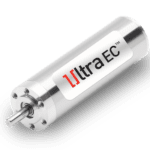Battery-powered motor applications need careful design work to match motor performance and power-consumption profiles to the battery type. Optimal motor and battery pairing relies on the selection of an efficient motor as well as a battery with the appropriate capacity, cost, size, maintainability, and discharge duration and curve.
By Scott McMillan • Senior Applications Engineer | Power Electric
Travis Lake • VP of Sales and Marketing | Power Electric

New commercial equipment designs continue to drive smaller, lighter, and more mobile solutions. This has spurred an accelerating transition from traditional wired designs to battery-powered equipment. Of course, proper motor selection is key to optimizing the performance of any automated equipment. However, battery-powered applications demand consideration of an additional factor — that of motor and battery interactions.
This article reviews the process for selecting motor-battery combinations that are suitable for commercial equipment.
.

Batteries and electric-motor power requirements
In any electric motor application, the target equipment performance dictates the required motor power. The rated power of the motor is calculated from the combination of speed, torque, and duty cycle of the application that in turn establishes the critical voltage, current, and capacity requirements of the battery.
The supply voltage and current directly correlate to the speed and torque that a motor will produce. In addition to voltage and current, capacity is the third critical factor in selecting the proper battery for a specific application. Battery capacity is based on the desired operational runtime of the equipment between recharging cycles and is simply the amount of charge a battery can hold.
The standard measure for battery capacity is milliampere-hours (mAh) or amp-hours (Ah), which indicates how long the battery will last based on the current it outputs. The calculation of the battery life at a certain current draw is the battery capacity (Ah) divided by output current (A) = Battery life (hours). For example, an AA battery with a rating of 2,500 mAh outputting 100 mAh will last approximately 25 hours.
Battery performance considerations
One motor parameter that affects the performance of battery-powered applications is efficiency. Maximizing motor efficiency helps minimize required power capacity — in turn allowing for a smaller and less costly battery. For this reason, brushless dc (BLDC) motors are preferred over brushed DC motors despite their higher upfront price. Brushed dc motors have lower upfront costs and are simpler to integrate. However, their relatively low efficiency may necessitate a higher-cost battery solution — or a reduction in the operating time between battery recharging cycles.

Typical battery-discharging processes require consideration of several performance considerations — including that of motor speed. With most battery types, terminal voltage decreases as the battery discharges. Motor speed is directly proportional to the battery voltage, so the motor speed will in fact decrease with dwindling terminal voltage. In addition, batteries exhibit decreasing terminal voltage as the output current (load) increases, which degrades motor speeds at higher torque loads.

These factors don’t consider the characteristics of the motor winding itself, for which output speed decreases as load on the motor increases — even with constant battery voltage.
One method to address this potential speed-fluctuation problem is to incorporate speed control electronics into the system. Such controls can help the motor maintains the target speed as the battery discharges over time … or as the load on the motor changes.
Motor output torque must also be considered, as the discharge current of a battery is limited. Because motor output torque is directly proportional to the current supplied, the maximum output torque of the motor could be limited by the battery discharge current rating. A properly sized battery should have a discharge current rating that meets or exceeds motor current-input requirements.
Other battery considerations for motor-driven applications
One essential criterion in battery selection is ensuring the battery will satisfy the motor’s voltage and current requirements when fully charged as well as continue to meet those requirements as the battery approaches full discharge. Weighing the tradeoffs between battery type, size, and cost while still meeting the critical performance requirements is the next step in the process.
All rechargeable and non-rechargeable battery designs rely on the conversion of chemical energy into electrical energy. Today, most small and rechargeable batteries are made using Lithium-Ion (Li-ion) technology due to its high energy density. These rechargeable and low-maintenance batteries are more expensive than traditional technologies such as Nickel-Cadmium based cells. Larger batteries have traditionally been lead-acid designs, although Li-ion has become increasingly popular due to longer life, smaller size and weight, and overall ease of maintenance and rechargeability compared to lead-acid batteries.
| RECHARGEABLE BATTERY TYPES | ADVANTAGES | DISADVANTAGES |
| Lithium-Ion (Li-ion) | Small and thin Very high power density Shorter charging cycles Efficient • Environmentally friendly |
Requires protection circuit to prevent overheating Overall capacity degrades over time Charger matched to battery |
| Nickel Cadmium (NiCd) | Inexpensive Runs at full capacity until almost fully discharged |
Reduced shelf life • Uses toxic metals Full discharge required before recharging • Charger must be matched to battery |
| Nickel Metal Hydride (NiMH) | High energy to volume ratio Environmentally friendly Runs at full capacity until almost fully discharged |
Requires full charge before use Over charging diminishes battery life Discharges at high rate |
| Lead acid | Tolerates wider temperature range Low self-discharge rate High tolerance to overcharge • Wide availability • low cost |
Bulky • low power density Long charge times Very toxic |
Battery size directly correlates to the energy storage capacity of a given battery. For product designs with minimal space available for batteries, like medical hand tools, utilization of a high energy density battery is beneficial despite the potential cost and capacity disadvantages.
The differing ways in which batteries discharge over time is another important factor in proper selection. While many of today’s energy-dense battery technologies maintain a relatively stable output voltage until they approach full discharge, traditional battery technologies offer a gradually decreasing voltage versus time curve until they reach full discharge.
As mentioned, the battery-discharge curve is important because output voltage directly affects the output speed of the motor … and understanding how close a battery is to full discharge can prevent damaging the battery and potentially the whole system. Allowing a battery to fully discharge during operation may ultimately damage the battery, rendering it no longer rechargeable. To prevent this, a preset cutoff voltage can disengage the motor once the battery voltage dips below the preset threshold. Determining and implementing the proper cutoff voltage is typically easier with a battery that has a gradual discharge curve than a battery with a flat curve.
Additional battery selection considerations include the number of recharging cycles the battery can endure, availability, and environmental factors.
Power Electric | www.powerelectric.com









Leave a Reply
You must be logged in to post a comment.